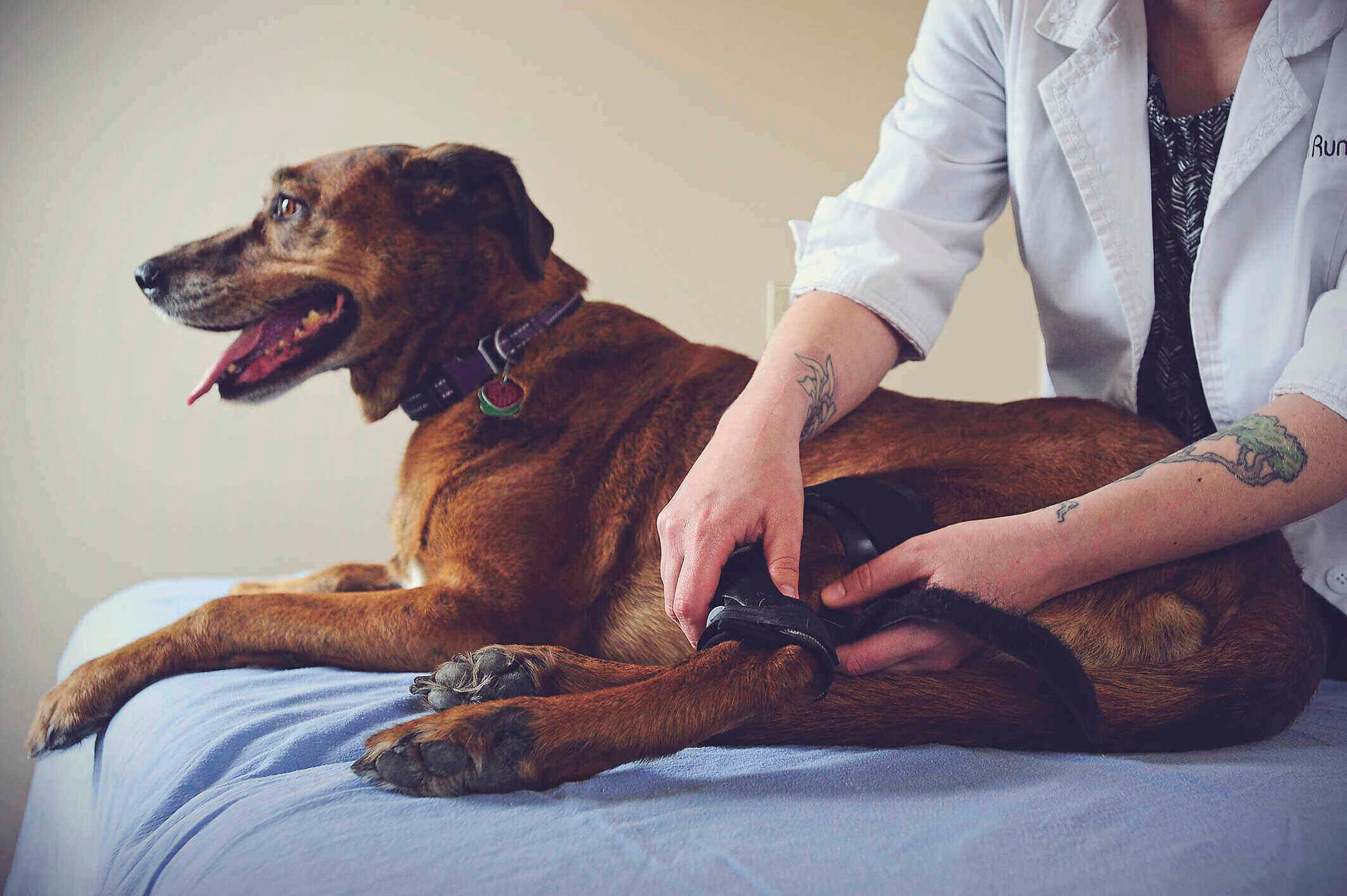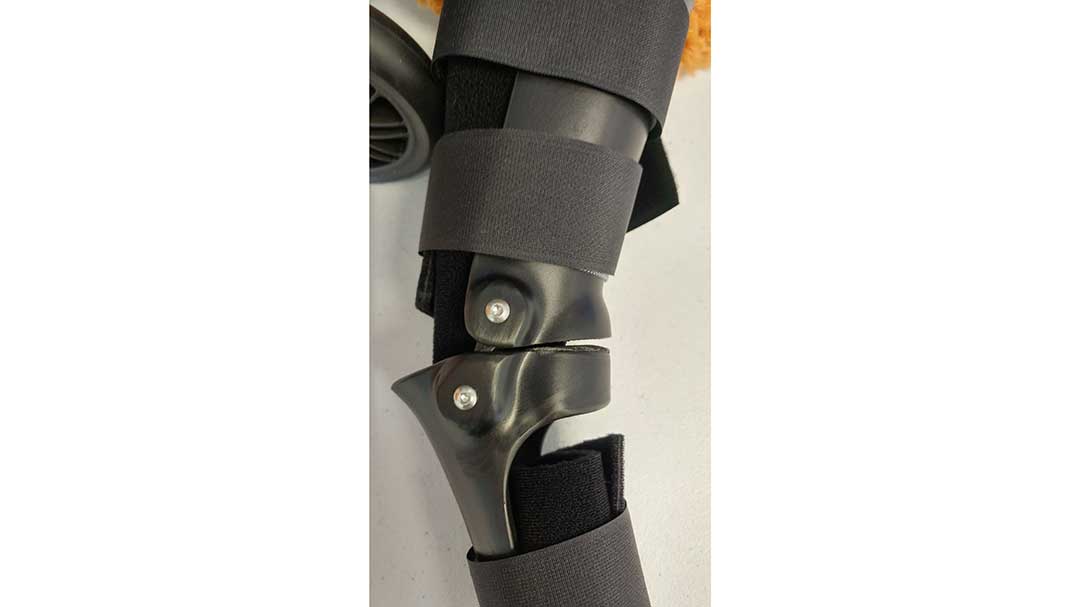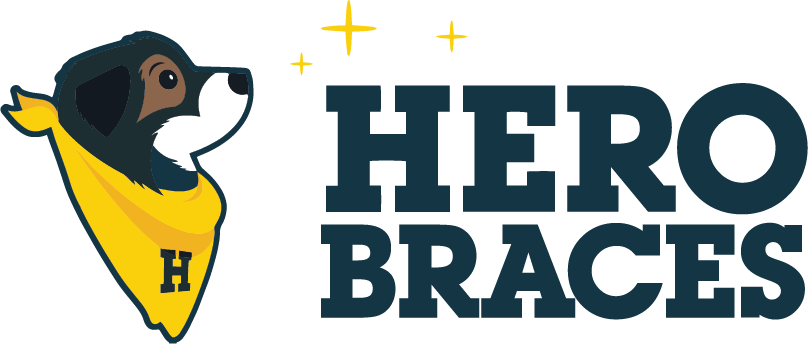Dog Bracing Made Simple
Tips and tricks to help your dog succeed with added support

Dog Bracing Made Simple
Talking to Your Veterinarian About Knee Braces for Dogs
Knees are joints. They give out over time. That’s certainly true of humans, and it’s also true of dogs. Dogs depend on knee ligaments for their joints to work much like we do, and when something goes wrong with a dog’s knee, it can be extremely painful and debilitating.
We all love our dogs, and we will do whatever we can to give them a happy, healthy and comfortable life. If your dog injures his or her knee, you’re most likely going to research the issue before you can see your veterinarian. During that research, you’re going to see information regarding surgical procedures and other treatments.
You may also come across information regarding knee braces for dogs. A dog knee brace may seem like a strange thing to ponder, but much like humans, there are situations where knee braces for dogs are a better option than surgery. Every case is different, but having an understanding of knee braces for dogs isn’t a bad thing before you speak to your vet.
However, suggesting a treatment to your veterinarian can be tough. We all care for our animal so much we want to learn as much as we can to help our pet. We tend to lean on Dr. Google in these times, just like how we learned about knee braces for dogs in the first place.
To make the conversation go smoothly, it's important to remember your Dr. went to many more years of veterinary school than Dr. Google. They did it because they care about animals very deeply. Appreciating this goes a long way with someone that may have had to deal with a deathly ill animal earlier in the day.
As with any conversation, people do not like to be surprised. If you can, get the info about the dog knee brace to your Veterinarian before you meet. Or at the very least give them time to process any new info you bring to them.
Here is an dog brace information sheet you can share with your veterinarian.
It is also important to understand the background. For many years, surgery was seen as the gold standard for treating a CCL/ACL injury in dogs. "A chance to cut is a chance to cure" has been a saying in the veterinary profession for a long time.
And for a long time, surgery was the only solution. There were simply no knee braces for dogs on the market that could adequately support a dog's leg, allowing them functionality and proper movement.
There were fabric wraps available, but they just didn't do the trick.
Then along came Hero. The Hero Brace was designed by both a veterinarian and an orthotist-prosthetist with a dog's knee unique biomechanics in mind. After many different designs and materials, the Hero Stifle Brace was created.
Our Hero Brace starts with the neoprene sleeve customized to a dog's unique anatomy and then uses a black polypropylene shell for lightweight durability. The placement of our Velcro wraps holds the dog knee brace in the optimum place to ensure a secure fit and maximum functionality without relying on a harness or heavy piece of equipment. The brace effectively allows the dog's knee to develop scar tissue and heal on its own while keeping the dog active and happy.
Sometimes Veterinarians can be resistant to the idea of knee braces for dogs simply because they haven't seen a product that works as effectively as Hero. Canine bracing is on the forefront of veterinary medicine, and gaining popularity all of the time. In the coming years, as more Vets graduate with the bracing skills, you are going to see more knee braces for dogs than you have to this point.
Our Hero Braces have been endorsed by Dr. Carrie Adrian, the first PhD recipient in Canine Biomechanics and veterinarian and Michelle Beck, DVM and canine rehabilitation expert. Another CCRP who has worked extensively with animals using Hero Braces is Robert Porter who will be speaking at the STAAR conference in April. We also teach bracing with the University of Tennessee Canine Rehabilitation Program, a world-renowned canine rehabilitation program.
If you have decided that you would prefer a non-surgical route because of concerns about complications of surgery, anesthesia, recovery time, financial reasons or just don't like the idea of surgery in general, tell your veterinarian. Great veterinarians continually want to learn more. They love working with you to make sure that your dog receives the best care possible. If that involves a dog knee brace, then that must be what's best for your furry friend.
Let her know that you are not comfortable with the idea of surgery and then tell her about Hero. Heck, give her our phone number.
We would love to discuss with her about what makes Hero braces so effective and how we can best put together a plan to help your dog get back on his feet.

Dog Bracing Made Simple
Torn ACL in Dogs - How Braces Help
Not all dogs can have surgery, but we still want to reduce their pain. Dog braces help your dog walk sooner.
The field of bracing is relatively new to Veterinary medicine, so not all doctors are familiar with how bracing works.
We started designing braces to help these doctors over 15 years ago. After helping thousands of dogs recover, this is what we know....
What The ACL Does
The ACL is a ligament that connects the bones above and below the knee. This ligament limits the bottom bone (the tibia) from sliding forward underneath the top bone (the femur.) This bad motion is called the cranial drawer. Veterinarians test to see if the ACL is torn by a cranial drawer test. Your vet pushes forward with their thumb and pulls backward with their fingers as shown by the red arrows. When the ACL is torn, the cranial drawer happens easily in your dog's knee. It scares and hurts your dog to put weight on the leg when this motion happens. So they quit using the leg, and over the following weeks, muscles start shrinking from disuse.
Arthritis Forms
If the cranial drawer motion is allowed to continue long term, arthritis forms in the joint. Arthritis can be painful and slow your dog's activities later in life. So it is important to limit this cranial drawer motion as much as possible to slow the formation of arthritis.A torn ACL is the most common leg injury in dogs. It can be caused by strenuous activity, obesity, age, breed or a combination of all of those factors.Talk to your veterinarian about a dog brace as a treatment option when your dog tears his ACL. The brace applies the opposite forces (green arrows) to limit the cranial drawer.
The Hero Brace is the only brace that provides support in these two areas with plastic versus trying to support the leg with velcro that will fail when a dog gets it dirty.Play sooner? Used alone OR to support surgery, a dog knee brace can provide a cost-effective permanent solution for your dog to play again.
Robert Porter shows off his rehab of torn ACL in a Golden Retriever without surgery. Watch below
About Hero Knee Braces for Dogs
With such a high risk of additional injury -- some estimates say that 60 percent of dogs with one ACL tear are likely to tear the other side -- there's no time to waste if your dog has a sudden and significant leg injury. That's why we advise all owners, whether you plan to pursue surgery or not, to devise a plan of action to prevent further injury, minimize arthritis and reduce atrophy of the muscles.
Working with veterinarians on the front lines of treatment, we've seen firsthand how our knee braces for dogs instantaneously provide mobility, confidence and a reduction of pain to suffering dogs of all ages. Just like with a person, an ACL tear is a serious injury, and hoping it'll get better on its own is no way to be a pet parent. But once you see how light, unobtrusive and easy it is to install and remove the Hero knee brace, we're confident that you'll do right by your dog.
Unlike typical straps and convoluted velcro contraptions, the Hero dog knee brace is made from durable co-polymer plastic, which provides the rigidity your dog needs to prevent further injury without weighing them down. Better yet, the Hero brace is great for all kinds of activities, so not only will your dog get back their sense of independence and freedom, but games of fetch, frisbee and even a dip in the pool are all sure to get their tails wagging.

Dog Bracing Made Simple
Tech Tips: Custom Brace Break-In Schedule
Just like “Breaking-in” a new shoe, it takes some time to get a dog used to wearing a custom wrist, ankle, or knee brace. When I first fit a brace I always go over the “Break-In Schedule”. By following this schedule your pet can quickly be wearing the brace 8 to 12 hours a day.
Here’s my Break-In Schedule
Day 1 wear 30 mins 2-3 times a day
Day 2 wear 1 hour 2-3 times a day
Day 3 wear 2 hours 2-3 times a day
Day 4 wear 3 hours 2-3 times a day
Day 5 wear 4 hours 2 times a day
Day 6 wear 6 hours
Day 7 wear 8 hours
Continue up to 12 hours a day.
Off at night while sleeping.
Pets rarely chew on the brace because it has a custom comfortable fit. It is wise to monitor your pet the first week to see how they do. If your pet does start chewing anywhere on the Brace please contact Hero Braces.
Being Successful with Proper Strap Tension
Straps and Neoprene cuffs should be adjusted several times a day. Just like you need to adjust your boot laces on a hike, the custom brace will need to be adjusted several times during the day. This happens because the hair coat compresses, swelling moves out of the limb, or the straps and padding stretch a bit during the “Break-In” period. Once a pet has worn the brace several days in a row you will get a feel for how often to adjust strap tension.
Remember any hair loss from rubbing should be reported immediately so the problem can be addressed by Hero Braces. Early reporting prevents sores and time out of the brace.
Taking Care of Your Investment
Remember to have your pet wear the brace daily, wash the brace weekly with dish soap and remove hair from the Velcro with a toothbrush. Parts should be air-dried.
Don’t use a wire brush for cleaning any of the custom brace parts. It is too harsh and will damage the brace.
At Hero Braces we are always ready to help and support you and your pet. Give us a call with any questions on our custom wrist, ankle, and knee braces.
By Paul Brumett DVM, CCRP, cAVCA

Dog Bracing Made Simple
Hero Braces Achilles Tendon Protocol - Conservative Management
Using a Tarsal Brace with Graduated Articulation
Most would agree that as practitioners we need to protect the Achilles tendon injury/repair early on and then slowly load the Achilles Tendon over time. That said, it is difficult to find a consensus on how to implement these needs. Below is a jumping-off point, a work in progress, based on my experiences and the knowledge gained from research of my peers. Please leave comments on how you think we should make it better.
Partial Achilles Tendon Rupture or Post -Operative Arthrodesis
Day 0 -Impression/casting at the time of diagnosis of a partial tear or end of surgery. Custom Orthotic will be taking the place of Bivalve Cast/Splint in 2-3 weeks.
Weeks 0-2 -After Casting/Impression is performed place in Bivalve cast/Splint with dorsiflexion of toes, if possible at 45 degrees. Tarsus will typically be at 135 degrees extension. Recheck the bivalve cast weekly.
Weeks 3-7 Sutures removed at 10-14 days post-op if used. Fit orthotic to pet. Orthotic is non-articulating. Wear in place of cast 24/7. Owner/practitioner to check 3-4 times a day for pressure sores. Begin rehab therapy. Continue rechecks every two weeks with Surgeon/RDVM.
Weeks 8-11 -Cut brace to allow 15 degrees of articulation if a partial tendon rupture. Continue rehab in the clinic and at home.
Weeks 12-16: Pet out of brace or using as a “Sports Brace,” times of high activity. The pet needs to have sufficient strength to maintain a normal standing angle in Hock. The pet should be challenged with the rear leg in a “Three-legged Stand.” Typically 135 Degrees of extension.
NOTE: Time intervals are stated as a guide. Some pets will need more or less time as they heal. This is where the “Art” of being a Practitioner is applied.
Items to consider:
Normal Range of Motion of the Tarsus. Flexion is 40 Degrees, and Extension is 170 Degrees in a relaxed pet.
The normal Standing angle of the Tarsus for Tarsal Arthrodesis is 135 Degrees.
According to Millis and Levine: Early partial weight-bearing and joint movement creates stress to promote parallel collagen alignment and increase tendon strength.
The Hero Brace Tarsal Orthotic may help bypass or relieve weight-bearing forces to the healing tendon, much like incorporating a walking ring into a cast or external fixator.
References:
Small Animal Surgery 3rd Edition. Fossum pgs 1322-1324
Veterinary Surgery Small Animal 2nd Edition. Johnston and Tobios Vol 1 pgs 1204-1209
Small Animal Orthopedics and Fracture Repair 4th Edition. Brinker, Piermattei and Flo pgs 674-678
Canine Rehabilitation and Physical Therapy. Millis and Levine 2nd Edition pg 573
“Calcaneal Tendon Tears in Dogs” Four Leg Rehab Inc Newsletter March-April 2012 Vol1 : Issue 1. Laurie Edge Hughes
“Post-Operative Management of Tendon Repairs” Four Leg Rehab Inc Newsletter May-June 2012 Vol 1 : Issue 2. Laurie Edge Hughes
Copyright Paul Brumett DVM, CCRP, cAVCA

Dog Bracing Made Simple
4 Tips - The Perfect Dog Brace Cast
Creating the perfect Casting can be summed up in four essential tips.
Position. Tight. High. Criss-Cross. Understand each to make yourself the Casting superstar for Custom Orthotics!
Let’s be clear on what “Casting” means in this article. Old school casts meant a kid with a broken arm had white plaster wrapped from elbow to wrist. These aren’t your old school casts!
The word “Cast or Casting” is used because it sounds like “cast.” The material is fiberglass casting tape, used to make an impression of the limb.
Position - The "Magic" of Walking Easily
This is where Hero Dog Braces really differ from other custom bracing. We ask for a cast with the dog lying on its side instead of standing.
This is important for a couple of reasons.
First is gravity. Gravity is really what feeds any deformity. The body weight pushes down on the legs, worsening the deformity. Casting a dog while lying down neutralizes gravity, allowing you to focus on getting the limb into the corrected position.
Second is rational. Can you really get a dog to stand still for 15 minutes while the cast sets? Much less "correct" the leg while doing this. In our vet clinic, our team holds the dog to trim its nails. Casting is no different.
So how do we correct the position? It is important to remember what deformity we are trying to support. The cranial drawer of a cruciate tear is a unique motion. We reduce it differently from angular deformities like varus or valgus.
When casting for the Knee Brace, pull the leg straight down perpendicular to the body. This will reduce the cranial drawer. Trying to cast in a “natural” standing position can cause the tibia to shift forward and adversely affect the fit and function of the custom orthotic.
For the Ankle Brace, place the foot and ankle in a natural standing position.
The Wrist Brace reduces any varus (foot angled towards midline) or valgus (foot angled away from midline) deformity and places the foot in a natural standing angle. Typically, the pet is straight through the wrist, but it can vary with breed. If this one is confusing, give us a call, and we can help guide you through the process.
Tight - Show us the Boney Landmarks
A Tight Casting is necessary for precision work. When the Hero Braces lab has exact dimensions taken from the Casting, they can create the best custom fit.
The Casting tape should be wrapped snugly to outline the bony prominences or bumps on the leg. If the Casting tape does not have sufficient tension, it will droop and fail to outline the prominences. This creates guesswork for the lab or necessitates another Cast.
Remember, no padding is added, just a layer of stockinette to protect the limb. This keeps the Cast true to the leg's shape. Because the Cast will be removed as soon as it hardens, you don’t need to worry about pressure points.
High - Capture the Groin
For the stifle, make sure the protective stockinette goes high into the groin or beyond the area to be cast. This is really important to have your helper focus on keeping the stockinette high. Notice where the hands are; it really helps to pull the stockinette high in the inside of the leg.
When starting the Cast, casting tape is spiraled up the leg with a 50% overlap. The Casting tape wraps high into the groin for Custom Dog Knee Braces or to the joint above for the Wrist and Ankle Braces. Be sure to wrap to the end of the foot for our Custom Wrist and Ankle Braces.
This technique enables the Hero Brace lab to identify landmarks, take measurements, and plan the proper dimensions of the Custom Brace.
Criss-Cross - Make it Strong AND Thin
This tip will make you happy when it comes time to cut off the cast. A thin cast is so much easier to cut through.
A 50% overlap of the Casting material wrapped around the limb is completed by spiraling down at a 45-degree angle, like the spiral on a candy cane. Criss-crossing the material's weave creates a strong yet light Cast. The three layers created are thin enough to be cut off easily, yet they stay together during shipping and at the lab.
For reference, download our Casting Tips PDF.
For a more in-depth video about casting. Watch our course from the UT Canine Rehab Lab
If you have any questions or need a little help, we are here to support you. Make a quick phone call or send us an email.
Hero Braces want to help you help more pets.






